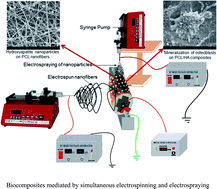Electrospun composite nanofibers and their multifaceted applications
Abstract
The re-exploration of the

* Corresponding authors
a
Center for Nanofibers & Nanotechnology, National University of Singapore, Singapore
E-mail:
nnijrv@nus.edu.sg, seeram@nus.edu.sg
Fax: +65 6773 0339
Tel: +65 6516 4272
b Department of Mechanical Engineering, National University of Singapore, Singapore
c School of Materials Science and Engineering, Nanyang Technological University, Singapore
The re-exploration of the

 Please wait while we load your content...
Something went wrong. Try again?
Please wait while we load your content...
Something went wrong. Try again?
R. Sahay, P. S. Kumar, R. Sridhar, J. Sundaramurthy, J. Venugopal, S. G. Mhaisalkar and S. Ramakrishna, J. Mater. Chem., 2012, 22, 12953 DOI: 10.1039/C2JM30966A
To request permission to reproduce material from this article, please go to the Copyright Clearance Center request page.
If you are an author contributing to an RSC publication, you do not need to request permission provided correct acknowledgement is given.
If you are the author of this article, you do not need to request permission to reproduce figures and diagrams provided correct acknowledgement is given. If you want to reproduce the whole article in a third-party publication (excluding your thesis/dissertation for which permission is not required) please go to the Copyright Clearance Center request page.
Read more about how to correctly acknowledge RSC content.
 Fetching data from CrossRef.
Fetching data from CrossRef.
This may take some time to load.
Loading related content
